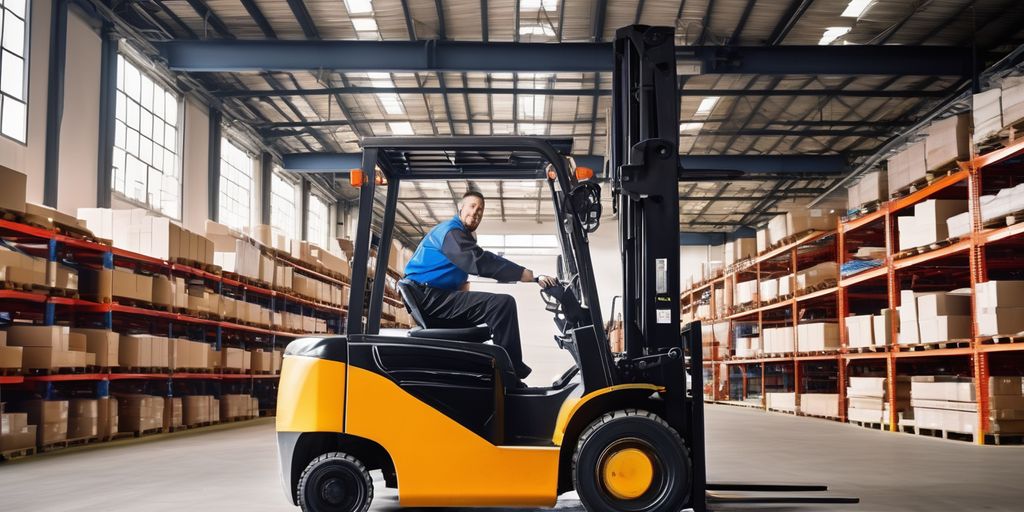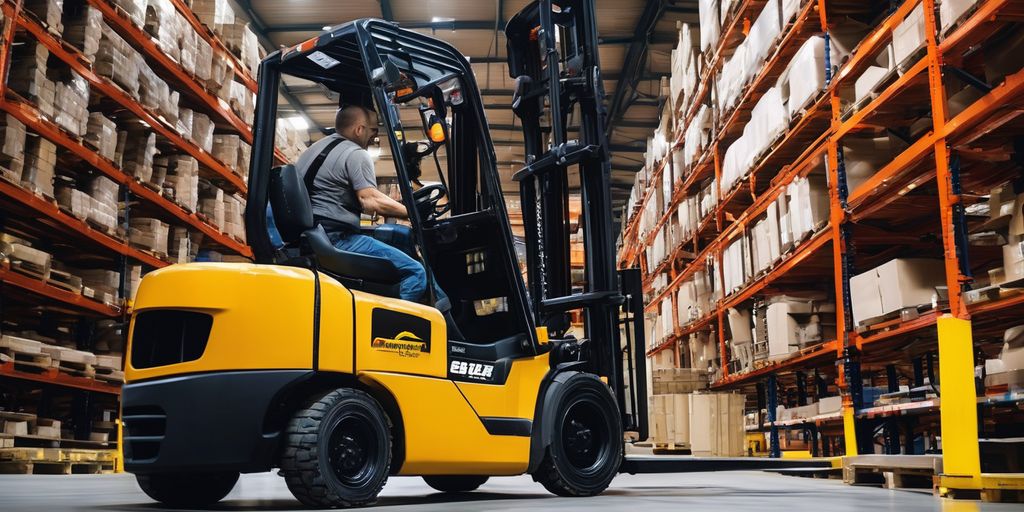In the diverse world of forklifts, selecting the right model tailored to your specific needs is crucial for enhancing efficiency and safety in your operations. This article explores the various types of forklifts available, delving into their unique features, applications, and considerations to guide you in making an informed decision.
Key Takeaways
- Understanding the different types of forklifts is essential for making an informed selection.
- Assess your business's specific needs and the types of inventory you handle to choose the appropriate forklift.
- Consider the safety features and ergonomic design of forklifts to ensure operator comfort and safety.
- Stay informed about technological advancements in forklifts, such as electric and hybrid models, to enhance efficiency.
- Consult with forklift experts and consider long-term maintenance costs when selecting a forklift.
Understanding Different Forklift Types

Counterbalance Forklifts
Counterbalance forklifts are among the most versatile and widely used types of forklifts. They are designed with forks protruding from the front and do not have extending arms, allowing them to counterbalance the load with a weight at the back. This design makes them ideal for a variety of lifting tasks in both indoor and outdoor settings.
Reach Trucks
Reach trucks are specialized for warehouse operations where high stacking and narrow aisles are common. They feature an extended reach mechanism that allows them to operate in tighter spaces and lift loads to greater heights. This capability is crucial for optimizing space efficiency in storage facilities.
Pallet Jacks
Pallet jacks, also known as pallet trucks, are the simplest form of forklifts, primarily used for moving pallets within a warehouse. They are highly maneuverable and suitable for low-level lifting, making them an essential tool for day-to-day operations in many logistics and distribution centers.
Key Considerations for Forklift Selection

Assessing Your Application Needs
When selecting a forklift, it's crucial to evaluate the specific needs of your operation. Consider the type of load, frequency of use, and the environment in which the forklift will operate. For instance, electric forklifts may be preferable in indoor environments due to their lack of emissions.
Understanding Forklift Capacities
Forklifts come in various capacities and sizes. It's essential to choose a forklift that can handle your maximum load requirements without compromising safety. Here's a quick guide to help you understand the typical capacities:
| Capacity (lbs) | Forklift Type |
|---|---|
| 3,000 - 7,000 | Small to Medium |
| 8,000 - 15,000 | Large |
| Over 15,000 | Heavy Duty |
Safety and Ergonomics
Ensuring the safety and comfort of the operator is paramount. Look for features like adjustable seats, clear visibility, and easy-to-use controls. Proper training and adherence to safety protocols are also critical to prevent accidents and enhance operational efficiency.
Industry-Specific Forklift Applications

Construction
In the construction industry, forklifts must be robust and versatile to handle a variety of materials on uneven terrains. Rough terrain forklifts and telescopic handlers are particularly suited for these environments. They are designed to ensure stability and efficiency when moving heavy loads across challenging sites.
Warehousing
Warehouses require highly efficient and maneuverable forklifts to optimize space and improve inventory management. Reach trucks and electric pallet jacks are ideal for these settings, offering excellent maneuverability and the ability to operate in narrow aisles. It's crucial to assess the specific requirements of your operation to ensure optimal efficiency and safety.
Manufacturing
Manufacturing plants often deal with heavy loads and require forklifts that can operate effectively in restricted spaces. Industrial lift trucks, often equipped with custom features, are tailored for these applications. They help in handling specific types of materials, ensuring that production processes run smoothly and safely.
Advancements in Forklift Technology

Electric and Hybrid Models
The shift towards electric and hybrid forklift models is a significant trend in the industry, driven by the need for environmentally friendly solutions and cost efficiency. These models offer reduced emissions and lower operating costs due to their energy-efficient designs.
Automation in Forklifts
Integration of automation and robotics has revolutionized warehouse operations, enhancing precision and reducing human error. Developments such as autonomous navigation systems allow forklifts to operate independently, improving safety and efficiency.
Energy Efficiency Improvements
Manufacturers are focusing more on energy efficiency, driven by environmental concerns and potential cost savings. Innovations like regenerative braking and high-efficiency batteries have significantly reduced the energy consumption of forklifts, making them more sustainable and cost-effective.
Practical Tips for Choosing the Right Forklift

Evaluating Cost vs. Performance
When selecting a forklift, it's crucial to balance initial costs with long-term performance. Consider both the purchase price and the operational costs, including maintenance and fuel or electricity. This evaluation helps ensure that the forklift will be a cost-effective solution for your needs.
Long-term Maintenance Considerations
Proper maintenance is key to extending the life of a forklift and ensuring safe operations. Create a maintenance schedule that includes regular checks and servicing. This proactive approach can significantly reduce downtime and repair costs.
Consulting with Forklift Experts
Before making a final decision, consult with forklift experts who can provide insights based on your specific requirements. They can help you understand the forklift capacities and safety features that are crucial for your operations. Their expertise can guide you in making an informed choice that aligns with your business needs.
Safety Guidelines for Forklift Operation

Operator Training
Proper training for operators is essential to ensure safety and efficiency in forklift operations. Training should cover all aspects of forklift use, including safety gear like hard hats and high visibility jackets, and the specific handling characteristics of different forklift models.
Routine Maintenance Checks
Regular maintenance checks are crucial to prevent accidents and maintain operational efficiency. Maintenance should include inspections of the oil, brakes, and tires, and should always be performed by trained personnel.
Safe Operating Procedures
Adhering to safe operating procedures is vital. This includes using seat belts, maintaining clear visibility at all times, and following load capacity limits. Implementing a routine safety checklist can significantly reduce risks associated with forklift operations.
The Future of Forklifts in Material Handling

Innovations on the Horizon
The forklift industry is poised for transformative changes with several innovations on the horizon. Advancements in battery technology are making electric forklifts more viable and efficient, a trend that is expected to continue. Additionally, the integration of IoT devices is set to enhance the connectivity and intelligence of forklift operations.
The Role of AI and Robotics
Autonomous forklifts represent a significant leap forward in warehouse automation. These vehicles, equipped with AI and robotics, can navigate complex environments without human intervention, reducing the risk of accidents and improving operational efficiency. This shift not only enhances safety but also optimizes the workflow within facilities.
Sustainability in Forklift Design
As environmental concerns become more pressing, the forklift industry is responding with more sustainable designs. New models are focusing on reducing emissions and increasing energy efficiency. The move towards electric and hybrid models is a clear indicator of this trend, reflecting a commitment to eco-friendly material handling solutions.
Conclusion
In conclusion, selecting the right forklift is pivotal for optimizing your operations, managing costs, and ensuring safety in your workplace. This article has provided a comprehensive overview of the different types of forklifts available, each designed to meet specific operational needs. Whether you require a rugged rough terrain forklift, a versatile reach truck, or a compact pallet jack, understanding the unique features and applications of each type will guide you in making an informed decision that aligns with your business requirements. Remember, the right forklift not only enhances efficiency but also contributes to the overall productivity and safety of your operations.
Frequently Asked Questions
What are the main types of forklifts available?
The main types of forklifts include counterbalance forklifts, reach trucks, and pallet jacks, each designed for specific tasks and environments.
How do I determine the right forklift for my business needs?
To choose the right forklift, assess your application needs, understand the types of inventory you handle, and consider the specific tasks the forklift will perform.
What should I consider regarding forklift capacities?
Consider the maximum weight the forklift needs to handle, the height to which materials need to be lifted, and the size of the loads to ensure you select a forklift with appropriate capacity.
How can forklift technology improve my operations?
Advancements in forklift technology such as electric and hybrid models, automation, and energy efficiency improvements can enhance operational efficiency, reduce costs, and improve safety.
What are some safety tips for operating forklifts?
Ensure operators are properly trained, conduct routine maintenance checks, and follow safe operating procedures to maintain a safe working environment.
How does the future of forklifts look in terms of innovation?
The future of forklifts includes innovations like increased automation, the integration of AI and robotics, and designs focused on sustainability, all aimed at improving efficiency and reducing environmental impact.




Leave a comment
This site is protected by hCaptcha and the hCaptcha Privacy Policy and Terms of Service apply.